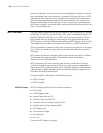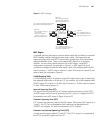248 CHAPTER 8: STP OPERATION
Multiple Spanning Tree Instance (MSTI)
Multiple spanning trees can be generated in an MST region and are independent
of one another. Each of these spanning trees is called an MSTI.
MSTI Region root
The MSTI region root refers to the root of the MSTI in an MST region. Each
spanning tree in an MST region can have a different topology with a different
region root.
Common Root Bridge
The common root bridge refers to the root bridge of the CIST. There is only one
common root bridge in the network.
Boundary port
The boundary port refers to the port located at the edge of the MST region. The
boundary port connects different MST regions, an MST region and an STP region,
or an MST region and an RSTP region. For MSTP calculation, the boundary port
has the same role on MSTI and CIST instance. For example, the boundary port as a
master port on a CIST instance should serve as a master port on every MSTI in the
region.
Port role
In the process of MSTP calculation, a port can serve as a designated port, root
port, master port, alternate port, or BACKUP.
■ The root port is the port through which the data is forwarded to the root.
■ The designated port is the one through which the data is forwarded to the
downstream network segment or switch.
■ Master port is the port connecting the entire region to the common root bridge
and located on the shortest path between them.
■ An alternate port is the backup of the master port. When the master port is
blocked, the alternate port takes its place.
■ If two ports of a switch are connected, there must be a loop. In this case, the
switch will block one of them. The blocked port is called BACKUP port.
A port can play different roles in different spanning tree instances.
Figure 5 illustrates the these concepts.


















